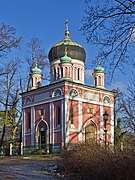
The House of Hohenzollern is a German royal dynasty whose members were variously princes, electors, kings and emperors of Hohenzollern, Brandenburg, Prussia, the German Empire, and Romania. The family came from the area around the town of Hechingen in Swabia during the late 11th century and took their name from Hohenzollern Castle. The first ancestors of the Hohenzollerns were mentioned in 1061.
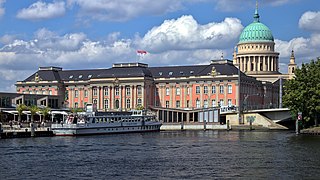
Potsdam is the capital and, with around 183,000 inhabitants, largest city of the German state of Brandenburg. It is part of the Berlin/Brandenburg Metropolitan Region. Potsdam sits on the River Havel, a tributary of the Elbe, downstream of Berlin, and lies embedded in a hilly morainic landscape dotted with many lakes, around 20 of which are located within Potsdam's city limits. It lies some 25 kilometres southwest of Berlin's city centre. The name of the city and of many of its boroughs are of Slavic origin.

The Potsdam Giants was the name given to Prussian infantry regiment No 6. The regiment was composed of taller-than-average soldiers, and was founded in 1675. It was eventually dissolved in 1806, after the Prussians were defeated by Napoleon. Throughout the reign of the Prussian king Friedrich Wilhelm I of Prussia (1688–1740), the unit was known as the "Potsdamer Riesengarde" in German, but the Prussian population quickly nicknamed them the Lange Kerls.

Frederick William III was King of Prussia from 16 November 1797 until his death in 1840. He was concurrently Elector of Brandenburg in the Holy Roman Empire until 6 August 1806, when the Empire was dissolved.

Frederick William IV, the eldest son and successor of Frederick William III of Prussia, reigned as King of Prussia from 7 June 1840 to his death on 2 January 1861. Also referred to as the "romanticist on the throne", he is best remembered for the many buildings he had constructed in Berlin and Potsdam as well as for the completion of the Gothic Cologne Cathedral.

The Order of the Black Eagle was the highest order of chivalry in the Kingdom of Prussia. The order was founded on 17 January 1701 by Elector Friedrich III of Brandenburg. In his Dutch exile after World War I, deposed Emperor Wilhelm II continued to award the order to his family. He made his second wife, Princess Hermine Reuss of Greiz, a Lady in the Order of the Black Eagle.

Prince Wilhelm Eitel Friedrich Christian Karl of Prussia was the second son of Emperor Wilhelm II of Germany by his first wife, Princess Augusta Viktoria of Schleswig-Holstein-Sonderburg-Augustenburg. He was born and died in Potsdam, Germany.
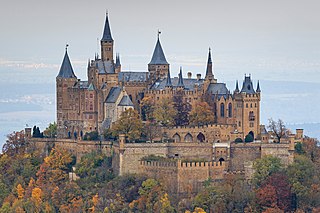
Hohenzollern Castle is the ancestral seat of the imperial House of Hohenzollern. The third of three hilltop castles built on the site, it is located atop Mount Hohenzollern, above and south of Hechingen, on the edge of the Swabian Jura of central Baden-Württemberg, Germany.
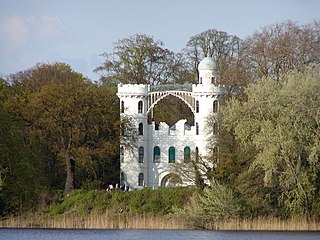
Pfaueninsel is an island in the River Havel situated in Berlin-Wannsee, in the district of Steglitz-Zehlendorf in southwestern Berlin, near the border with Potsdam in Brandenburg. The island is part of the Palaces and Parks of Potsdam and Berlin UNESCO World Heritage Site because of its outstanding Prussian architecture, and is a popular destination for day-trippers. Pfaueninsel is also a nature reserve in accordance with the EU Habitats Directive and a Special Protection Area for wild birds.

The Orangery Palace is a palace located in the Sanssouci Park of Potsdam, Germany. It is also known as the New Orangery on the Klausberg, or just the Orangery. It was built on behest of the "Romantic on the Throne", King Friedrich Wilhelm IV from 1851 to 1864.
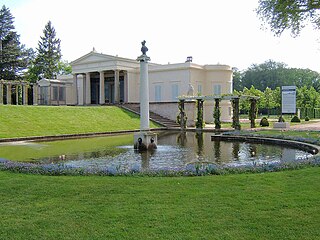
Charlottenhof Palace or Charlottenhof Manor is a former royal palace located southwest of Sanssouci Palace in Sanssouci Park at Potsdam, Germany. It is best known as the summer residence of Crown Prince Frederick William. Today it is maintained by the Prussian Palaces and Gardens Foundation Berlin-Brandenburg.

Prince Frederick Charles Alexander of Prussia was a younger son of Frederick William III of Prussia. He served as a Prussian general for much of his adult life and became the first Herrenmeister of the Order of Saint John after its restoration as a chivalric order. Nevertheless, he is perhaps remembered more often for his patronage of art and for his sizable collections of art and armor.

Jelenia Góra Valley in Poland is a big valley at the Silesian northern side of the Western Sudetes and next to Kłodzko Valley the largest intermontane basin of the Sudetes. It is situated at an altitude of 250–400 meters above sea level and covers an area of 273 km2. In the 19th century, the lovely landscape attracted the Prussian high nobility, which built magnificent palaces, manors and parks. The enormous number of stately homes turned the valley into one of the most important garden landscapes in Middle Europe.

Prince Joachim Viktor Wilhelm Leopold Friedrich Sigismund of Prussia was a German World War I fighter pilot and member of the House of Hohenzollern. He was the son of Prince Friedrich Leopold of Prussia and Princess Louise Sophie of Schleswig-Holstein-Sonderburg-Augustenburg, married in 1916.

The 1st Guards Grenadiers were an infantry regiment of the Guard Corps within the Royal Prussian Army and a Guards Grenadiers regiment of the Imperial German Army.

Babelsberg Park is a 114 hectare park in the northeast of the city of Potsdam, bordering on the Tiefen See lake on the River Havel. The park was first designed by the landscape artist Peter Joseph Lenné and, after him, by Prince Hermann von Pückler-Muskau and Karl Friedrich Schinkel, by order of the then-prince William I and his wife, Augusta. Located on a hill sloping down to the lake, the park and castle are part of the Palaces and Parks of Potsdam and Berlin, which were inscribed on the UNESCO World Heritage List because of their unique architecture and testimony to the development of landscape design.
The French Colony of Magdeburg was a separate and independent community that existed from 1685 to 1808 in the city of Magdeburg. It co-existed, without any clear boundaries, with the citizens of the city and with the somewhat later colony of German Palatines. Its residents were Huguenot refugees, under the protection of the Elector of Brandenburg-Prussia. The colony had its own church, town hall, mayor, court and even its own home guard, and spoke French every day in all of them and on its streets.

Park Glienicke, is an English landscape garden in the southwestern outskirts of Berlin, Germany. It is located in the locality of Wannsee in the Steglitz-Zehlendorf borough. Close to Glienicke Bridge the park is open to the general public. The park is part of the UNESCO World Heritage Site Palaces and Parks of Potsdam and Berlin. Within the ensemble it is one of the five main parks, the others being Sanssouci Park, New Garden, Babelsberg Park and Peacock Island (Pfaueninsel). Regarding diversity in gardening styles within the Potsdam park ensemble Park Glienicke is only superseded by Sanssouci Park. Furthermore, it is a park especially characterized by one personality due to the intense involvement of Prince Charles of Prussia. The park covers approximately 116 hectares

Gustav Emil Bernhard Bodo von Kessel was a German general who served in the Austro-Prussian War, the Franco-Prussian War and World War I.



